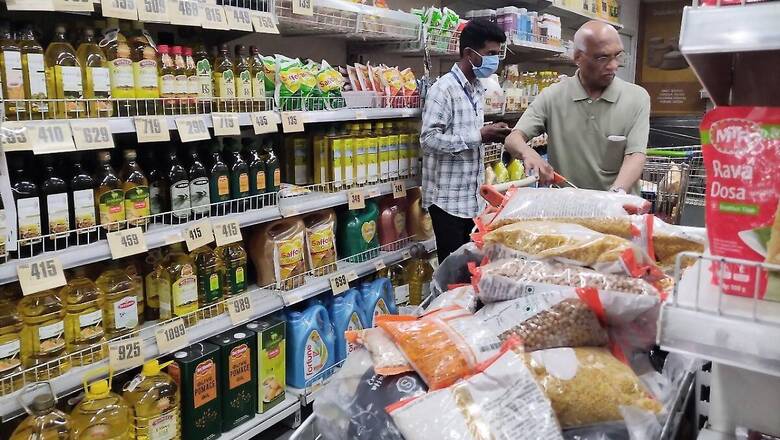
views
The aam aadmi faces a double whammy. Home and vehicle loan EMIs won’t fall and the household budget will also remain stressed as the Reserve Bank of India (RBI) has decided not to lower interest rates due to rising inflation. How bad has inflation been?
The central bank has said in its latest assessment that retail inflation – prices at which we buy vegetables, cereals, milk – rose sharply in September and again in October. Food inflation surged to double digits and prices of even non-food items picked up. Surging inflation has put a stop to the rate cut spree by the RBI, seen since March this year. It is quite likely that interest rates have bottomed out and from here on, EMIs will only go northwards.
Why the inflation numbers are worrying is clear from these two points: 1) there is a “substantial” difference between wholesale and retail prices, indicating supply side issues and profiteering by middlemen, and 2) Prices of dals, atta and even vegetables could soften going forward but other food prices are likely to persist at elevated levels. Your cooking oil has become dearer too. In fact, the inflation print is expected to remain near the upper limit of RBI’s own band for the next six months and even in the next fiscal.
The central bank has said that CPI inflation is projected at 6.8% in the current quarter, 5.8% in January-March next year and 5.2-4.6% in April-September 2021. The inflation band is 4% and plus/minus 2%.
A survey by brokerage IIFL shows how steep price hikes have been across a wide range of products. Lux soap prices have risen by 25% or Rs 50 per kg in one year and Tata Tea Premium now costs 20% more at Rs 520 a kg. Using the phone is also pinching the pocket as various pre-paid packs now cost up to 40% more compared to the same time last year. Prices of even two wheelers and SUVs have gone up by anywhere up to 20%.
So with inflation remaining a headache, the RBI has been left with no option but to pause further rate cuts. It seems balancing GDP growth (through lower rates) and inflation is trickier for the central bank than previously thought – all this while after the pandemic, it had been focused on boosting growth through rate cuts and liquidity measures but galloping prices have now virtually forced it to prioritise inflation taming instead.
Since the beginning of Covid-19 and subsequent lockdowns, lending rates were lowered by 115 basis points or by 1.15% to 4%. And even though actual transmission of lower interest rates by banks to consumers has been varied, the lending rate cuts have meant EMIs for home, auto and other loans have reduced. Also, because of the moratorium announced since March, there has been some respite in payment schedules of these loans. Both of these concessions are over, at least for now.
Analysts at ratings agency CARE Ratings have pointed out that they do not foresee a rate cut in this fiscal year, as inflation would remain at elevated levels and is unlikely to cool below the RBI’s target of 6%. “Future rate cuts likely only post March 2021 and would be driven by the inflation readings,” they said.
Also, not only is RBI a bit flustered over inflation, it has also moved the needle quite a bit on its own earlier GDP growth forecasts. In October, it had projected GDP growth at negative 5.6% for the current quarter (October-December) – this has now been projected at positive 0.1%. For January-March quarter, 0.5% earlier has improved to 0.7% and for 2020-21 as a whole, the projection has improved to -7.5% from -9.5%.
While these new growth projections have been made on the back of recent government data which showed a better-than-expected economic revival in the July-September period, one must remember that GDP growth is still not broad based – it is not happening in all measurable categories. According to initial estimates, GDP growth in Q2 came in at -7.5% against -23.9% degrowth in the June quarter and over 4.4% in the same quarter last year. The Q2 numbers were better than projections by analysts and economists.
Now, as rural growth prospects improve and urban areas also show promise, it is hoped that the overall economy will gradually improve. This would, ideally, lead to better capacity utilisation at factories, more economic activity and possibly also more jobs. But what about inflation? While the RBI has flagged supply side risks and the scourge of middle men, the government has not been seen doing enough to tackle these issues.
A case in point is the ongoing farmers’ protests, demanding removal of middlemen and assurance on state support for crops. Also, the government has been hesitant in announcing substantive steps to boost private consumption, tied down by fiscal worries, and this has further complicated the situation. Given these diverse pressures on the economy, the next few months may not bring any major relief for the aam aadmi.
Read all the Latest News, Breaking News and Coronavirus News here



















Comments
0 comment